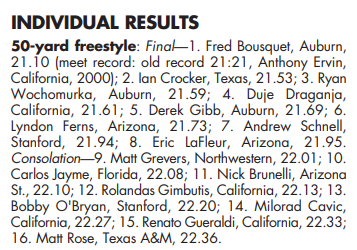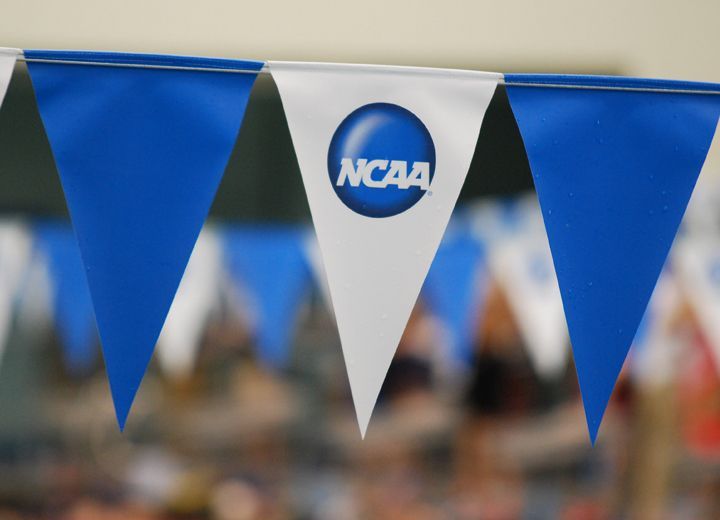Self-styled fact checkers descended like vultures on the comments section of a recent SwimSwam article that referenced a world record falling at the 2000 NCAA Championships. Confusion abounded as many defended the notion that there is no such thing as a ‘yards World Record.’ On semantics and technicalities, that’s not correct, though it is true that modern day World Aquatics doesn’t recognize any yards World Records. But in actuality, those readers–like many others from generations that were born after these meets happened (millennials, let that sink in)–were unaware that the 2000 and 2004 NCAA Championships were actually held in a short course meters format.
According to the 2004 NCAA results record book:
“In 2000, the NCAA Men’s and Women’s Swimming and Diving Committee established a format in which during Olympic years the meet would be swum in short-course meters instead of the usual short-course yards to give Olympic hopefuls a chance to post times in the NCAA meet that would equate with the meters format used in the Olympic Trials.”
Though the above statement seems to imply meters times were required to help chances of qualifying for the Olympic Trials, SCM and LCM weren’t the only formats accepted in 2000. In an OMEGA Timing archive of the 2000 US Olympic Trials Results, there are three distinct entry types.
The example below, pulled from the OMEGA archives, is the Women’s 50-meter Freestyle Start List (Entry List) . The fastest entry times appear to have a 40: preceding them, they are likely SCY entries; the next fastest set of times have a 20: preceding them and are likely to be the SCM entries; lastly, the times with no minute marks were the LCM entries.

This entry format, however, was abandoned in the 2004 Olympic Trials, where only LCM times could qualify a swimmer for the meet.
With the 2000 Olympic Trials accepting yards entry times and the 2004 Olympic Trials only accepting long course meters entry times, one can only wonder the exact purpose for running the 2000 and 2004 NCAA Championships as short course meters.
Former Arizona Wildcat and multiple All-American Dave Rollins shared his experience with the meters format at the 2004 NCAA Championships. “As an athlete we didn’t really know why NCAA’s was SCM, but we were excited for the opportunity to set new records,” Rollins said. “It was a wild meet; I remember diving in for the breast leg of the 200 medley relay in finals and hearing them announce, ‘that’s a new world record!’ as I’m on the blocks and in the air.”
Not even the bookkeepers could keep it straight. The 2000 NCAA results record book lists the women’s 50 freestyle as “50-yard freestyle,” even though the event was swum short course meters. They eventually got it straight for the women’s event in 2004, yet they mixed it up for the men that year, mismarking the result once again as “50-yard freestyle”:

Women’s 50-meter freestyle result mismarked.

Men’s 50 meter freestyle result mismarked (p. 199).
But who can blame them? It was a strange and uncertain period in swimming history for everyone involved. “Not knowing what the times were was pretty crazy,” Rollins remarks, “Ian [Crocker] set the world record in the 100 free in like a 46, and I’m thinking [in] yards times, ‘that’s not that fast, right? But it’s a World Record, so I guess it’s really good.’”
Ian Crocker and many others broke World Records during the two unconventional years. Below are the recorded WRs for each NCAA Championship meet:
SCM WRs broken at the 2000 NCAA Championships:
- Women’s 200-meter medley relay, 1:49.23, California (Haley Cope, Staciana Stitts, Waen Minpraphal, Joscelin Yeo) (previous record 1:49.47, Sweden, 1999)
- Women’s 400-meter medley relay, 3:57.46, Georgia (Courtney Shealy, Kristy Kowal, Keegan Walkley, Maritza Correira) (previous record 3:57.62, Japan, 1999)
- Men’s 50-meter freestyle, 21.21, Anthony Ervin, California (previous record 21.32, Mark Foster, Great Britain, 1998)
- Men’s 100-meter breaststroke, 57.66, Ed Moses, Virginia (previous record 58.51, Roman Sloudnov, Russia, 2000)
- Men’s 200-meter breaststroke, 2:06.40, Ed Moses, Virginia (previous record 2:07.79, Andrei Korneev, Russia, 1998)
- Men’s 200-meter individual medley, 1:54.65, Attila Czene, Arizona State (ties previous record set by Jani Sievinen, Finland, 1994)
SCM WRs broken at the 2004 NCAA Championships:
- Men’s 50-meter freestyle, 21.10, Frederick Bousquet, Auburn
- Men’s 100-meter freestyle, 46.25, Ian Crocker, Texas
- Men’s 100-meter backstroke, 50.32, Peter Marshall, Stanford
- Men’s 200-meter backstroke, 1:50.64, Aaron Peirsol, Texas
- Men’s 100-meter butterfly, 49.07, Ian Crocker, Texas
- Men’s 200-meter individual medley, 1:53.93, George Bovell, Auburn
- Men’s 400-meter medley relay, 3:25.38, Texas (Aaron Peirsol, Brendan Hansen, Ian Crocker, Garret Weber-Gale)
Other uncanny instances exist throughout NCAA history, such as the inclusion of the long course 1500-meter freestyle in 1924,1932, and 1934-1962, in spite of the rest of the meet being in short course yards. Some of those 1500s were swum in long course pools (likely 50 or 55 yards), while others were swum in short course pools. Below is a list of dated events from NCAA history and their ‘forever’ record holders (assuming these events are never reinstated).
Discontinued Events Records
- Men’s 220-yard freestyle, Murray Rose, Southern California, 2:00.6, 1961
- Men’s 440-yard freestyle, 4:17.9 Murray Rose, Southern California, 1961
- Men’s 1,500 meter freestyle, 18:05.9 (LCM), George Breen, Cortland St., 1956
- Men’s 150-yard backstroke, 1:31.8, Allan Stack, Yale, 1948
- Men’s 300-yard medley relay, 2:42.2, Ohio St. (Yoshi Oyakawa, Albert Wiggins, Ed Kawachiki), 1955.
- Women’s 50-yard backstroke, 25.46, Sue Walsh, North Carolina, 1983
- Women’s 50-yard breaststroke, 28.80, Angelika Knipping, Alabama, 1983
- Women’s 50-yard butterfly, 24.26, Jill Sterkel, Texas, 1983
- Women’s 100-yard individual medley, 55.74, Tracy Caulkins, Florida, 1982

Bring back SCM NCAAs!!!
Great article, thanks!
Would love to see NCAAs in SCM or LCM format at least once every 4 years.
As long as they are running it SCY, they should have the 100 IM. Everyone loves the 100 IM. Fun to swim, fun to watch. What’s not to like?
Along the same lines, I’d love to see dual meets (College, HS, club) in non-regulation pools sometimes. It would put the focus squarely on racing in a pool of 20 yds, 33 yds, 55 yds, 24 meters, or whatever. (What other non-regulation distances have people seen?)
Bring back the 100 IM!!!
Yards should count as world records. Have you seen the foreign invasion happening to college swimming!
Are there events we are swimming today that will seem equally bizarre in 50 years?
1,000 free yards. It’s already bizarre in almost all countries.
All the SCY events, maybe.
I think it’ll be bizarre we aren’t racing the 100IM right now. I also think it’ll be bizarre we aren’t competing mixed relays right now…not sure how it would work with separate conference and NCAA meets, but I could definitely see it becoming more commonplace since the Olympics recognizes it now.
Interestingly, some of the 1500s you mention were 1650s, but we’re labeled 1500. In 1951 it is labeled 1500 meters, but there are splits for 1650 yards for the top 8 in the results. I expect other years around the era had the same occurrence.
They may have swam the 1659 ij a 55yard pool
The pool in 1951 was a 25 yard pool, but that is a possibility some of the years.
I still think if bousquet had swum a fully rested 50 Yard Free during the super suit era, he would have gone 17.8.
But he did do that. In fact, he wore two super suits at once.